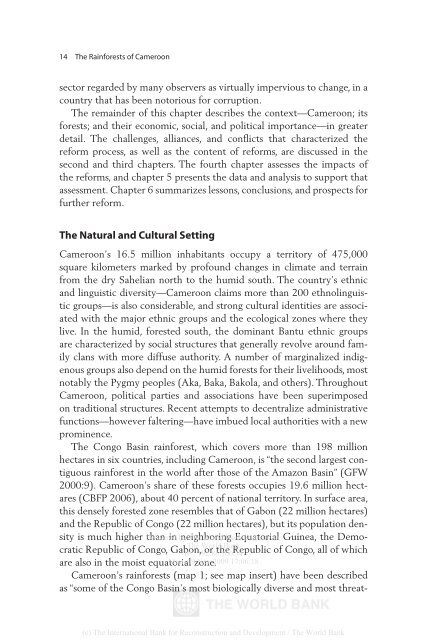The Rainforests of Cameroon - PROFOR
The Rainforests of Cameroon - PROFOR
The Rainforests of Cameroon - PROFOR
- No tags were found...
You also want an ePaper? Increase the reach of your titles
YUMPU automatically turns print PDFs into web optimized ePapers that Google loves.
14 <strong>The</strong> <strong>Rainforests</strong> <strong>of</strong> <strong>Cameroon</strong>sector regarded by many observers as virtually impervious to change, in acountry that has been notorious for corruption.<strong>The</strong> remainder <strong>of</strong> this chapter describes the context—<strong>Cameroon</strong>; itsforests; and their economic, social, and political importance—in greaterdetail. <strong>The</strong> challenges, alliances, and conflicts that characterized thereform process, as well as the content <strong>of</strong> reforms, are discussed in thesecond and third chapters. <strong>The</strong> fourth chapter assesses the impacts <strong>of</strong>the reforms, and chapter 5 presents the data and analysis to support thatassessment. Chapter 6 summarizes lessons, conclusions, and prospects forfurther reform.<strong>The</strong> Natural and Cultural Setting<strong>Cameroon</strong>’s 16.5 million inhabitants occupy a territory <strong>of</strong> 475,000square kilometers marked by pr<strong>of</strong>ound changes in climate and terrainfrom the dry Sahelian north to the humid south. <strong>The</strong> country’s ethnicand linguistic diversity—<strong>Cameroon</strong> claims more than 200 ethnolinguisticgroups—is also considerable, and strong cultural identities are associatedwith the major ethnic groups and the ecological zones where theylive. In the humid, forested south, the dominant Bantu ethnic groupsare characterized by social structures that generally revolve around familyclans with more diffuse authority. A number <strong>of</strong> marginalized indigenousgroups also depend on the humid forests for their livelihoods, mostnotably the Pygmy peoples (Aka, Baka, Bakola, and others). Throughout<strong>Cameroon</strong>, political parties and associations have been superimposedon traditional structures. Recent attempts to decentralize administrativefunctions—however faltering—have imbued local authorities with a newprominence.<strong>The</strong> Congo Basin rainforest, which covers more than 198 millionhectares in six countries, including <strong>Cameroon</strong>, is “the second largest contiguousrainforest in the world after those <strong>of</strong> the Amazon Basin” (GFW2000:9). <strong>Cameroon</strong>’s share <strong>of</strong> these forests occupies 19.6 million hectares(CBFP 2006), about 40 percent <strong>of</strong> national territory. In surface area,this densely forested zone resembles that <strong>of</strong> Gabon (22 million hectares)and the Republic <strong>of</strong> Congo (22 million hectares), but its population densityis much higher Delivered than in by neighboring <strong>The</strong> World Bank Equatorial e-library to: Guinea, the DemocraticRepublic <strong>of</strong> Congo, Gabon, IP : 192.86.100.34 or the Republic <strong>of</strong> Congo, all <strong>of</strong> which<strong>The</strong> World Bankare also in the moist equatorial Mon, 09 zone. Nov 2009 17:06:18<strong>Cameroon</strong>’s rainforests (map 1; see map insert) have been describedas “some <strong>of</strong> the Congo Basin’s most biologically diverse and most threat-(c) <strong>The</strong> International Bank for Reconstruction and Development / <strong>The</strong> World Bank
















